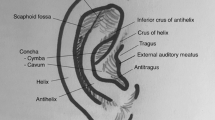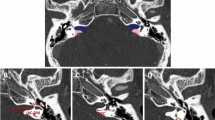Abstract
Background
This study aimed to follow the growth dynamics of auricular dimensions from birth to the age of 18 years. The norms of dimensions at different ages, the peak growth period and the maturity age of the dimensions are essential information to Physicians for early clinical diagnosis or for deciding the optimal time for surgery to correct abnormalities.
Methods
For this study, 2,147 children belonging to central Indian population were measured in at least three sequential sessions. Eight dimensions including the physiognomic length and width of the ear and its morphologic width; conchal length, width, and depth; and lobular length and width were measured using anthropometric technique. Three new dimensions (tragal length and height and maximum width of the antihelix) were introduced in the study. Three indices (auricular, conchal, and lobular) also were derived.
Results
Most dimensions exhibited very rapid growth during the first 3–6 months of infancy and thereafter proceeded at a slow pace until adulthood. The smaller dimensions (conchal depth, tragal height, and maximum width of the antihelix) increased continuously throughout the growth period. At birth, most of the dimensions were 52–76 % of their adult size, while tragal length and height were less than half their adult size. Unlike the other dimensions, the lobule length was smaller in males, probably due to the higher frequency of hypoplastic and bow-shaped lobules among them. The width dimensions matured earlier, at 5.6–11 years, whereas the maturity age of lengths varied from 12 to 16 years.
Conclusions
The data generated in the current study will be useful to Physicians as a guideline in correcting auricular deformity and in constructing age progression charts of the external ear. Knowledge concerning the maturation age of the ear will help law enforcement authorities in deciding when to use it for establishing personal identification.
Level of Evidence III
This journal requires that authors assign a level of evidence to each article. For a full description of these Evidence-Based Medicine ratings, please refer to the Table of Contents or the online Instructions to Authors www.springer.com/00266.



Similar content being viewed by others
References
Farkas LG (1978) Ear anthropometry of normal and anomalous ears. Clin Plast Surg 5:401–412
Farkas LG, Posnick JC (1992) Growth and development of regional units of head and face based on anthropometric measurements. Cleft Palate-Craniofac J 29:301–302
Farkas LG, Posnick JC, Hreczko TM (1992) Anthropometric growth study of the ear. Cleft Palate Craniofac J 29:324–329
Kalcioglu MT, Miman MC, Toplu Y, Yakinci C, Ozturan O (2003) Anthropometric growth study of normal human auricle. Int J Pediatr Otorhinolaryngol 67:1169–1177
Knußmann R (1988) Wesen und Methoden der Anthropologie.Band I, Gustav Fischer Verlag, Stuttgart
Lakshminarayana P, Janardhan K, David HS (1991) Anthropometry for syndromology. Indian J Pediatr 58:253–258
Martin R, Saller K (1957) Lehbuch der anthropologie. Gustav Fischer Verlag, Stuttgart
Niemitz C, Nibbrig M, Zacher V (2007) Human ears grow throughout the entire lifetime according to complicated and sexually dimorphic patterns: conclusions from a cross-sectional analysis. Anthropol Anz 65:391–413
Purkait R, Singh P (2007) Anthropometry of the normal human auricle: a study of adult Indian men. Aesthet Plast Surg 31:372–379
Sforza C, Grandi G, Binelli M, Tommasi DG, Rosati R, Ferrario VF (2009) Age- and sex-related changes in the normal human ear. Forensic Sci Int 187:110.e1–110.e7
Sharma A, Kumar A, Singh P (2008) Age-dependent changes in lobules of human ear and its influence on individual identification. Indian J Forensic Med Toxicol 2:1–3
Vogel FG, Motulsky AG (1982) Human genetics: problem and approaches. Springer, New York
Acknowledgments
The author is grateful to the subjects and their parents for their cooperation during the study and to the Indian Council of Medical Research, New Delhi for funding the study. The author gratefully acknowledges the assistance of Ms. Ankita Asati and Mr. Sandeep Prasad Daksha in preparing the manuscript.
Conflict of interest
The author has no conflict of interest.
Author information
Authors and Affiliations
Corresponding author
Rights and permissions
About this article
Cite this article
Purkait, R. Progression of Growth in the External Ear from Birth to Maturity: A 2-Year Follow-Up Study in India. Aesth Plast Surg 37, 605–616 (2013). https://doi.org/10.1007/s00266-013-0097-1
Received:
Accepted:
Published:
Issue Date:
DOI: https://doi.org/10.1007/s00266-013-0097-1




